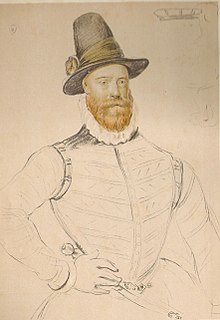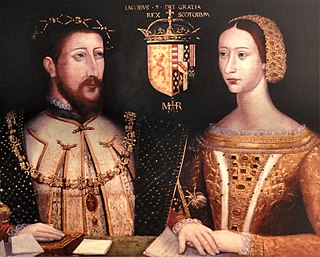Related Research Articles

James Douglas,4th Earl of Morton was the last of the four regents of Scotland during the minority of King James VI. He was in some ways the most successful of the four, since he won the civil war that had been dragging on with the supporters of the exiled Mary, Queen of Scots. However, he came to an unfortunate end, executed by means of the Maiden, a predecessor of the guillotine.

Sir William Kirkcaldy of Grange was a Scottish politician and soldier who fought for the Scottish Reformation but ended his career holding Edinburgh castle on behalf of Mary, Queen of Scots and was hanged at the conclusion of a long siege.
Archibald Douglas, Parson of Douglas, was also Parson of Glasgow, a Senator of the College of Justice, Ambassador to Queen Elizabeth I of England, and a notorious intriguer.
Sir Henry Killigrew was a Cornish diplomat and an ambassador for the Kingdom of England in the sixteenth century. He was several times employed by Elizabeth I in Scottish affairs and served as one of the English appointees to the Council of State of the Netherlands in the United Provinces in 1586 and 1587–1589. He served as a Member of Parliament for Newport & Launceston in 1553, for Saltash in 1563, and for Truro in 1571–2.
Sir James MacGill, Lord Rankeillor of Nether Rankeillour. was a Scottish courtier and Senator of the College of Justice.

George Seton V, 7th Lord Seton (1531–1586), was a Lord of the Parliament of Scotland, Master of the Household of Mary, Queen of Scots, and Provost of Edinburgh. He was the eldest son of George Seton, 6th Lord Seton, and Elizabeth Hay, a daughter of John Hay, 3rd Lord Hay of Yester. His childhood and schooling were in France.

Alexander Erskine of Gogar was a Scottish landowner and keeper of James VI of Scotland at Stirling Castle.

The Marian civil war in Scotland (1568–1573) was a period of conflict which followed the abdication of Mary, Queen of Scots, and her escape from Lochleven Castle in May 1568. Those who ruled in the name of her infant son James VI fought against the supporters of the Queen, who was exiled in England. Edinburgh Castle, which was garrisoned in her name, became the focus of the conflict and surrendered only after an English intervention in May 1573. The conflict in 1570 was called an "intestine war in the bowels of this commonwealth", and the period was called soon after an "intestine war driven by questions against authority."
John Seton, Lord Barns was a Scottish diplomat, courtier and judge.
Annabell Murray, Countess of Mar (1536–1603), was a Scottish landowner, courtier and royal servant, the keeper of the infant James VI and his son Prince Henry at Stirling Castle
Margaret Douglas, Countess of Bothwell was a Scottish aristocrat and courtier.
Nicolas Errington was an English soldier, military engineer, and administrator.
Thomas Kerr of Ferniehirst was a Scottish landowner, Roman Catholic and supporter of Mary, Queen of Scots. He and Jean Scott ended the feud between the Scott family and the Kerrs. Thomas and Jean were both involved with supporting Mary, Queen of Scots.

James Cockie was a goldsmith in Edinburgh. He helped mint coins in Edinburgh Castle during the Marian Civil War and was hanged as a counterfeiter on 3 August 1573.

The jewels of Mary, Queen of Scots (1542–1587), are mainly known through the evidence of inventories held by the National Records of Scotland. She was bought jewels during her childhood in France, adding to those she inherited. She gave gifts of jewels to her friends and to reward diplomats. When she abdicated and went to England many of the jewels she left behind in Scotland were sold or pledged for loans, first by her enemies and later by her allies. Mary continued to buy new jewels, some from France, and use them to reward her supporters. In Scotland her remaining jewels were worn by her son James VI and his favourites.

John Mosman was a Scottish goldsmith based in Edinburgh who served the royal court and was involved in gold mining.

James Mosman was a Scottish goldsmith.

James Douglas of Spott was a Scottish landowner and conspirator.
Michael Gilbert was an Edinburgh goldsmith and financier.
Edward Hart or Hairt was a Scottish goldsmith based in Edinburgh.
References
- ↑ Jean Munro & Henry Steuart Fotheringham, Edinburgh Goldsmith's Minutes (Edinburgh, 2006), pp. 27-28.
- ↑ Calendar of State Papers Foreign, 1575-1577, p. 150: TNA SP 52/26/2 f.218.
- ↑ William Boyd, Calendar State Papers Scotland, vol. 5 (Edinburgh, 1907), pp. 182, 197-8.
- ↑ National Records of Scotland, Will of Michaell Sym, CC8/87/5 p. 591.